If you want to boost the health and productivity of your zucchini plants this season, then you’ve come to the right place! In this ultimate guide, we will walk you through the tried-and-true technique of staking zucchini plants. By providing them with the necessary support, you can ensure stronger stems, increased airflow, and even higher yields of those delicious, homegrown zucchinis. Say goodbye to sprawling vines and hello to a more organized and efficient zucchini garden! So, grab your gardening gloves and let’s get started on this exciting journey to mastering the art of staking zucchini plants.
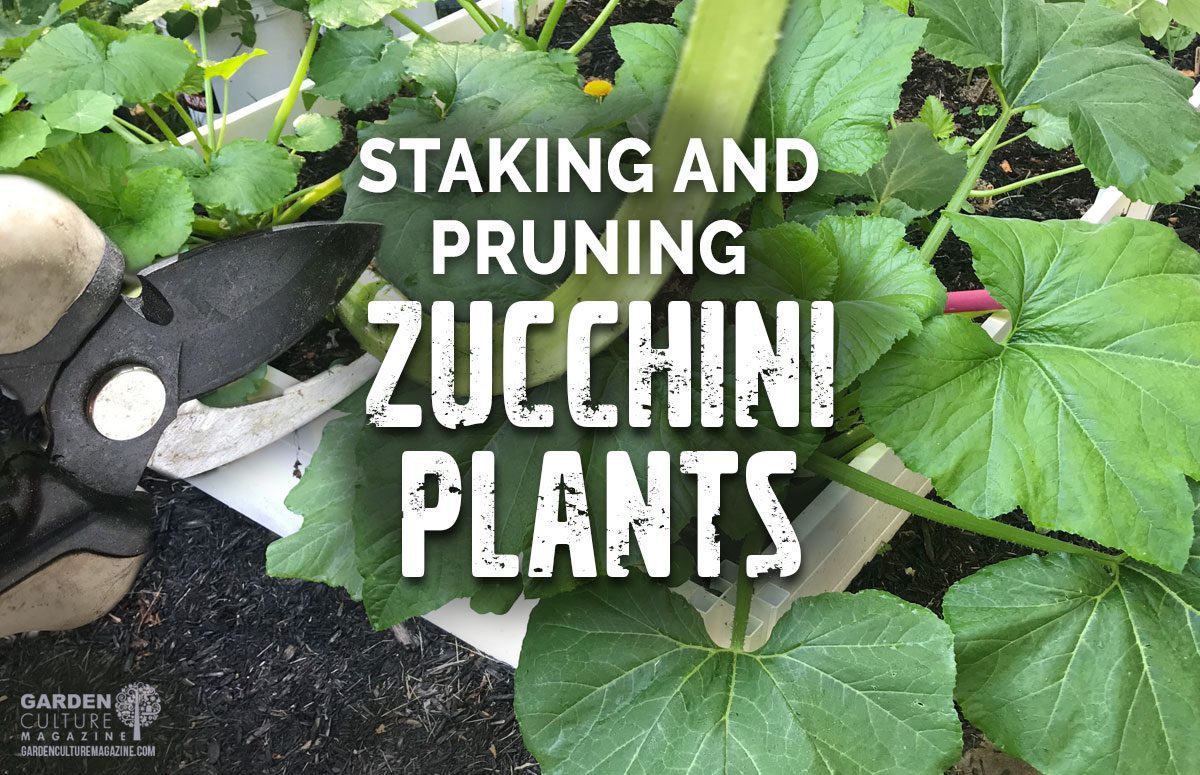
Choosing the Right Staking Materials
When it comes to staking your zucchini plants, choosing the right materials is essential for providing the necessary support and ensuring the health and productivity of your plants. There are several options available, including wooden stakes, metal stakes, and bamboo stakes.
Wooden stakes
Wooden stakes are a popular choice for staking zucchini plants due to their accessibility and affordability. They are sturdy enough to support the weight of the plants and can be easily customized to fit your specific needs. However, it is important to choose quality wooden stakes that are made of rot-resistant wood, such as cedar or redwood, to ensure they last throughout the growing season.
Metal stakes
Metal stakes offer a more durable and long-lasting option for staking zucchini plants. They provide excellent stability and can withstand the weight of heavy fruits. Metal stakes are available in various sizes and designs, allowing you to choose the most suitable option for your garden. Keep in mind that metal stakes can heat up in direct sunlight, so it is advisable to place them strategically to avoid any potential damage to the plants.
Bamboo stakes
Bamboo stakes are a sustainable and eco-friendly choice for staking zucchini plants. They are lightweight yet strong, making them an ideal option for supporting the plants. Bamboo stakes are readily available and cost-effective, making them a popular choice among gardeners. However, they may not be as durable as wooden or metal stakes, so regular monitoring and replacement may be necessary to prevent any sudden collapses due to wear and tear.
Preparing the Zucchini Plants for Staking
Before you begin staking your zucchini plants, there are a few preparatory steps you should take to ensure their health and maximize their growth potential.
Pruning the plants
Pruning is an essential step in preparing your zucchini plants for staking. It involves removing any excess foliage, side shoots, and unproductive branches to encourage better airflow, prevent disease, and improve access to sunlight. Pruning also allows for easier management and training of the plants onto the stakes or supports.
Clearing the surrounding area
Clearing the area around your zucchini plants is crucial to minimize competition for nutrients, water, and sunlight. Remove any weeds, grass, or other vegetation that may hinder the growth and health of your plants. Providing a clean and well-maintained environment will help your zucchini plants thrive and produce abundant fruits.
Watering the plants
Proper hydration is vital for the health and development of your zucchini plants. Before staking, ensure that your plants are well-watered to promote strong root growth. Watering deeply and consistently will encourage the plants to establish themselves firmly in the soil, making them more resistant to any stress caused by staking and supporting.
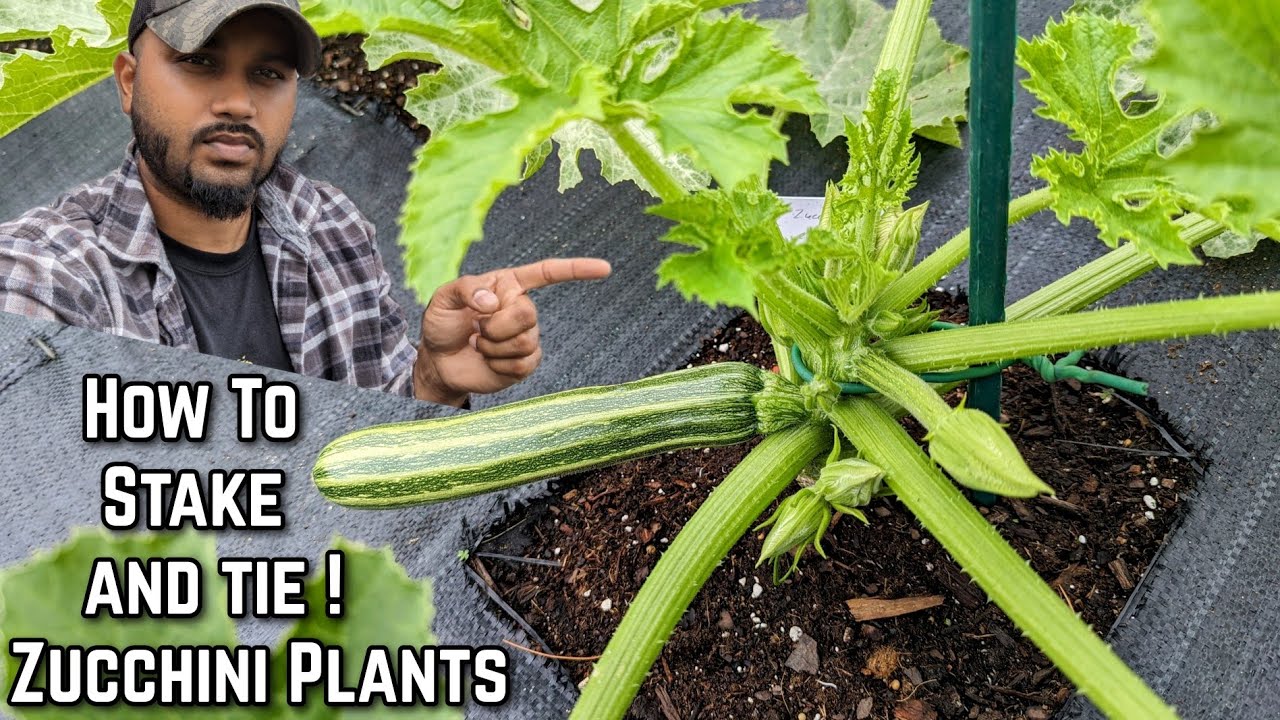
Different Staking Methods
There are several staking methods available for zucchini plants, each with its own advantages and considerations. Let’s explore three common methods: the single stake method, the cage method, and the trellis method.
Single stake method
The single stake method involves using a single sturdy stake to support each zucchini plant individually. This method provides vertical support and helps prevent the plants from sprawling on the ground. It is particularly suitable for smaller gardens or when space is limited.
Cage method
The cage method utilizes wire or wooden cages placed around the zucchini plants. This method provides 360-degree support, allowing the plants to grow and expand while maintaining their upright position. The cage method is ideal for larger zucchini plants or gardens with ample space.
Trellis method
The trellis method involves using a trellis structure or framework to support the zucchini plants. Trellises can be made of wood, metal, or even bamboo. This method allows the plants to climb and grow vertically, maximizing space within your garden. The trellis method is well-suited for gardens with limited space or for gardeners who enjoy the aesthetics of trained vines.
Single Stake Method
The single stake method is a straightforward and effective way to support your zucchini plants. Here’s how to go about it:
Choosing a sturdy stake
When selecting a stake for the single stake method, choose one that is sturdy and tall enough to provide adequate support. Opt for materials such as wood or metal, ensuring that it is strong and durable.
Installing the stake
Before planting your zucchini seeds or seedlings, place the stake in the ground near the plant’s intended location. Push it deep into the soil, ensuring it is firmly planted and able to withstand the weight of the mature plant.
Securing the plant to the stake
As your zucchini plant grows, gently guide the main stem towards the stake and secure it using soft ties or materials. Avoid using materials that may damage the plant’s stem, such as wire or twine. Allow some flexibility for the stem to grow and expand while providing essential support.
Using ties or soft materials
To secure the zucchini plant to the stake, use soft ties or materials that won’t harm the stem or restrict growth. Consider using strips of fabric, plant clips, or even pantyhose. These materials are gentle on the plants while providing sufficient support.
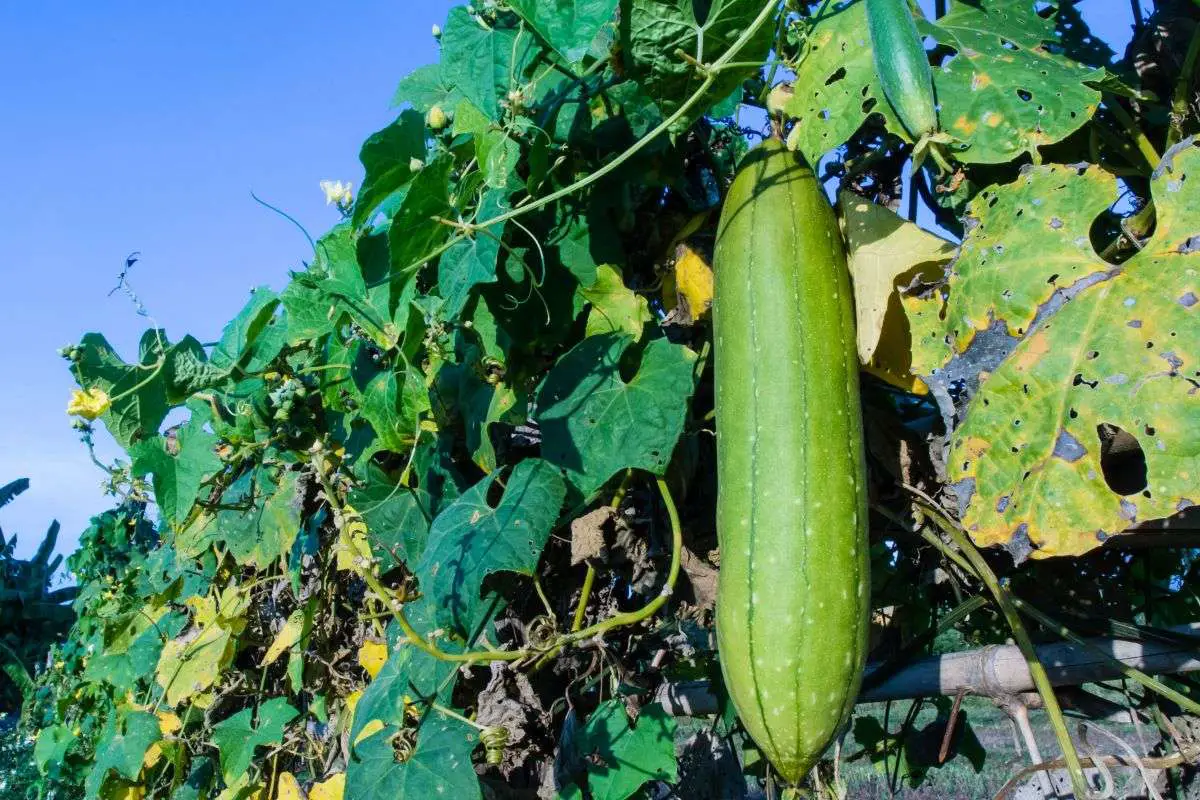
Cage Method
The cage method is an excellent option for those who prefer a more robust support system for their zucchini plants. Follow these steps to implement the cage method effectively:
Selecting a suitable cage
When choosing a cage for the zucchini plants, opt for a design that allows ample space for growth and proper airflow. Wire or wooden cages with a diameter of 12-18 inches are typically suitable for most zucchini varieties. Ensure that the cage is tall enough to accommodate the plant’s maximum height.
Placing the cage around the zucchini plant
After planting the zucchini seedlings or seeds, carefully position and surround each plant with a cage. Make sure the cage is aligned with the plant’s center and leaves enough room for the plant to expand and grow. The cage should be close enough to prevent sprawling but not so tight that it restricts the natural upward growth of the plant.
Securing the cage
Once you have positioned the cage around the zucchini plant, secure it firmly in the ground to prevent it from toppling over. Ensure that the cage is stable and capable of withstanding strong winds or heavy rainfall.
Training the plant within the cage
As the zucchini plant grows, gently guide the main stem and any side shoots within the confinement of the cage. This will help maintain an organized and structured growth pattern while ensuring the plant has the necessary support to withstand the weight of the fruits.
Trellis Method
The trellis method offers a vertical support system for zucchini plants, allowing them to climb and utilize vertical space effectively. Here’s how to implement the trellis method:
Building or purchasing a trellis
Before planting your zucchini seeds or seedlings, you will need to either build or purchase a trellis structure suitable for your garden. Trellises can be made from wood, metal, or bamboo. Consider the size of your zucchini plants and the space you have available when determining the appropriate dimensions for your trellis.
Positioning the trellis
Place the trellis in the ground where you intend to grow your zucchini plants. Ensure that it is sturdy and anchored properly to prevent any instability. Position the trellis where it will receive maximum sunlight and airflow, as this will promote healthy plant growth.
Securing the trellis
Once the trellis is properly positioned, secure it firmly in the ground using stakes or by burying the bottom ends of the trellis securely. This will provide stability and prevent the trellis from tipping or collapsing under the weight of the plants.
Training the zucchini vines on the trellis
As the zucchini plants grow, gently guide the vines towards the trellis, encouraging them to intertwine and climb naturally. Use soft ties or materials to secure the vines to the trellis, allowing them to grow and expand while receiving the necessary support.
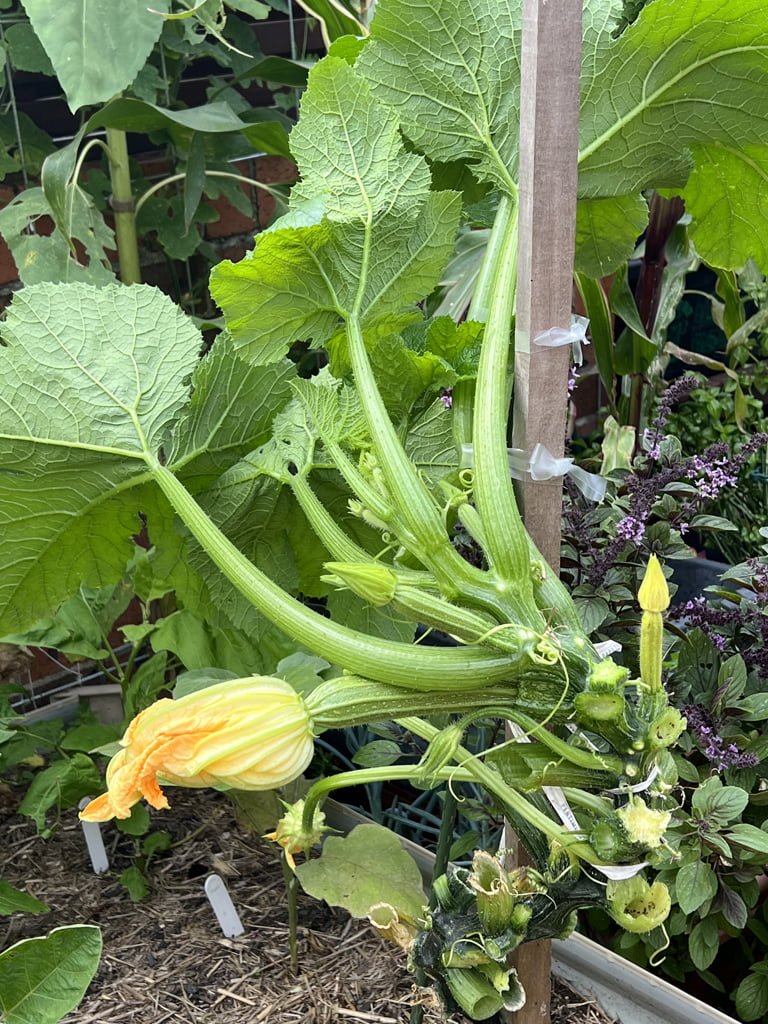
Maintaining and Supporting the Staked Zucchini Plants
Once your zucchini plants are staked using the chosen method, it is crucial to regularly maintain and support them to ensure their health and maximize their productivity.
Regularly checking the stakes
Regularly inspect the stakes or support structures to ensure they remain stable and in good condition. Check for any signs of damage, instability, or loosening of ties. If necessary, reinforce the stakes or replace damaged ones promptly to prevent any potential accidents or collapses.
Adjusting the ties or supports
As your zucchini plants grow, they may require additional support or adjustment. Regularly assess the ties or soft materials securing the plants, making sure they are not too tight or constricting the growth. Adjust the ties as necessary, allowing for flexibility and adequate plant expansion.
Pruning side shoots
To promote better airflow and prevent overcrowding, regularly prune any side shoots that emerge from the main stem or branches. Removing excessive vegetation will redirect energy towards fruit production and strengthen the main structure of the plant.
Watering and fertilizing
Zucchini plants require consistent watering and regular feeding to thrive. Monitor the soil moisture levels and ensure the plants receive adequate water, particularly during hot or dry periods. Additionally, provide the necessary nutrients through organic fertilizers or compost to support healthy growth and fruit development.
Common Issues and Troubleshooting
While staking your zucchini plants can significantly minimize potential issues, it is essential to be aware of common problems and how to address them promptly.
Stakes becoming unstable
If you notice that the stakes are becoming unstable or leaning, they may not be securely anchored in the ground. Reinforce the stakes by pushing them deeper into the soil or providing additional support, such as driving additional stakes into the ground alongside the existing ones.
Plants leaning to one side
Leaning zucchini plants can be a sign that they are not adequately supported or secured to the stake, cage, or trellis. Adjust the ties and ensure that the plants are properly aligned and supported. If necessary, provide additional ties or materials to straighten the plant’s growth.
Inadequate support for heavy fruits
If your zucchini plants bear heavy fruits, they may require additional support to prevent the branches from bending or breaking. Consider using slings or netting to cradle the fruits, providing support and preventing any damage.
Overgrowth and tangled vines
Zucchini plants are known for their vigorous growth and can quickly overtake their allotted space. Regularly monitor the growth and pruning needs of your plants, removing any excessive foliage or tangled vines. This will promote better airflow and reduce the risk of diseases caused by moisture and lack of sunlight penetration.
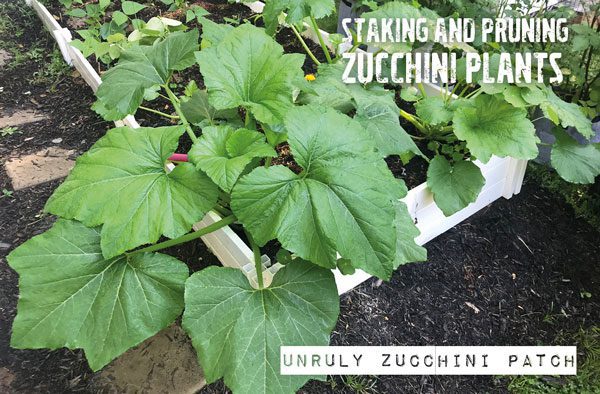
Harvesting and Caring for Zucchini Plants
Once your zucchini plants are staked and well-maintained, it is important to properly care for them to ensure a bountiful harvest.
Harvesting zucchini
Zucchini should be harvested when they reach a size suitable for consumption, usually around 6 to 8 inches in length. Regularly check your plants for mature fruits and harvest them promptly. Leaving zucchini on the plant for too long can result in oversized fruits with a tough texture.
Preventing diseases and pests
Regularly inspect your zucchini plants for any signs of diseases or pests. Maintaining good airflow, practicing proper sanitation, and providing adequate sunlight will minimize the risk of fungal infections and pest infestations. If problems arise, promptly address them through organic pest controls or treatments specific to the issue at hand.
Extending the growing season
To extend the growing season and enjoy fresh zucchini for longer, consider employing season-extending techniques such as row covers or cold frames. These can protect the plants from frost or cool temperatures, allowing them to continue producing even in less favorable weather conditions.
Conclusion
Staking your zucchini plants is a fundamental aspect of their care that ensures proper support, optimal growth, and abundant harvests. By choosing the right staking materials, preparing the plants adequately, and implementing suitable staking methods, you can enjoy healthy and productive zucchini plants throughout the growing season. Regular maintenance, troubleshooting common issues, and providing proper care will further enhance your success in cultivating these versatile and delicious vegetables. Happy gardening and happy harvesting!



